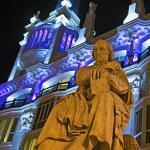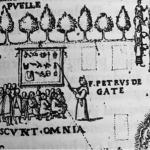The new issue of the Atlantic has a fine piece on a topic that has long been dear to my heart. This is by the excellent journalist Ariel Sabar, and it is entitled “The ‘Secret’ Gospel and a Scandalous New Episode in the Life of Jesus. A Columbia historian said he’d discovered a sacred text with clues to Jesus’s sexuality. Was it real?” The text in question is the so-called Secret Gospel of Mark allegedly discovered by Morton Smith. Not to give too many spoilers, but the answer to that last question, that “Was it real?”, is a resounding “No!” That is what many us have been arguing at length for a great many years, but it is very good to have this solid indictment of Smith and his claims.
Here, I will present an adaptation of an article I published a decade or so back in Books and Culture which puts forward my own contributions to this whole debate. I think the point about the Anglo-Saxon Attitudes novel is critical in understanding what Smith thought he was doing.
In 1973, Morton Smith announced a spectacular discovery that promised to reshape the understanding of the New Testament. The authenticity of that alleged find is still hotly debated, and I belong to the school that believes it to be fiction. Actually, I would go further. I think his find was from the first inspired by fiction, by novels. One of those fictional sources is now well known, but I believe that I am the first to draw attention to another.
Clement of Alexandria and a Secret Gospel of Mark
Smith’s book was Clement of Alexandria and a Secret Gospel of Mark, and it was taken sufficiently seriously to be published by Harvard University Press. Smith claimed that in 1958, he had made an astonishing find at the monastery of Mar Saba, in Palestine. In a previously unknown letter from c.200, Clement of Alexandria wrote to one “Theodore,” discussing the various versions of Mark’s gospel circulating in his era. There was the canonical gospel that we know, but he also knows another secret version. He quotes a portion of this text, which concerns a young man whom Jesus instructed by night. But in yet a third edition, condemned by Clement, the Carpocratian sect had elaborated that passage by adding overt sexual content – “naked man with naked man.” While Clement’s church condemned that deviant book, it approved the “mainstream” clandestine text. Moreover, the alternative passage quoted by Clement was part of a whole expanded gospel, most of which is now lost. This has come to be known as the Secret Gospel of Mark.
Apart from its implications for the canonical text of the New Testament, Clement’s letter suggested that much early Christian doctrine was transmitted through esoteric or mystical teaching, much of which was subsequently lost.
Forgery?
This was explosive stuff. But did Secret Mark ever exist? Put another way, is Clement’s supposed letter authentic? If not, when was it composed? Might it be an early forgery – perhaps third century – or did Smith forge it himself? Although some scholars had doubts from the beginning, fears of libel suits made them nervous about speaking openly before Smith’s death in 1991. Also, many highly qualified and reputable scholars accepted the discovery at face value, claiming that it shed invaluable light on the process by which the gospels were composed – and many highly reputable figures still continue to believe it.
Arguments against the reality of Secret Mark abound, and the case against Smith himself gains strength the deeper we dig into his background. By any standard, this was an epochal discovery, and it strains belief that it should have been made by a scholar who had previously been writing on precisely the passages elaborated in Clement’s Letter. From the late 1940s, too, a decade before his alleged discovery, he had been working on Clement, and planning a book on Mark’s Gospel.
Moreover, Smith himself had a deep personal interest in occult and antinomian traditions, and for many years he corresponded with Gershom Scholem, the great scholar of Jewish messianism and mysticism. (The correspondence was edited by Guy G. Stroumsa, as Morton Smith and Gershom Scholem: Correspondence 1945-1982 (Brill 2008).) Smith’s 1978 book, Jesus the Magician, depicted Jesus himself as a wandering Jewish sorcerer. From this perspective, the alleged letter of Clement, with its exposé of the ancient church as a base for secret mystical instruction, was precisely what he might have hoped to find to confirm everything he ever believed. It’s far, far, too good to be true.
Smith’s First Source: The Mystery of Mar Saba
In 2001, I pointed out an odd fact about the location of Smith’s alleged find, in the monastery of Mar Saba. In 1940, Canadian evangelical James H. Hunter published a novel called The Mystery of Mar Saba, which depicted a plot to undermine the morale of the Christian West. To accomplish this, Nazi agents planted a forged gospel text called the Shred of Nicodemus, with the goal of disproving the Resurrection, and they did this at Mar Saba itself. This proto-Indiana Jones thriller novel was popular, running into multiple editions. As I have noted elsewhere, the fact that Smith’s alleged find occurred at Mar Saba is either strong proof of the text’s authenticity, in that nobody would have dared invent such a thing, or else it is a tribute to the unabashed chutzpah of a forger. If you are going to fake a fossil discovery, you would have too be very brave to do it at Piltdown.
If in fact Secret Mark was a hoax, then Smith was almost advertising the fact, presumably to show his contempt for the gullibility of academe. Not only would they miss the obvious clues hinting at forgery – the Mar Saba connection – but they would even accept the outrageous idea of placing Jesus in a homoerotic context. Even in 1973, this notion was far more shocking than any suggestion that the church had once tolerated multiple editions of the gospel text.
But Mystery of Mar Saba was not the only novel to portray such a deliberate deception, and another book may actually be more relevant to the present discussion. I stress that I have no direct evidence that Smith read this other work, any more than he did Mystery, but the parallels to the Secret Mark affair are striking.
Smith’s Second Source: Anglo-Saxon Attitudes
In 1956, English author Angus Wilson published Anglo-Saxon Attitudes, which was widely reviewed and read, in North America as well as Britain. (WARNING: Many spoilers follow). This brilliant and very funny satire tells the story of an academic fraud at an archaeological site.
Understanding the book’s origins require a little background in contemporary British archaeology, at a time when fraud and “planted” materials were much in the news. The legendary case was of course that of Piltdown Man, involving ancient human fossils supposedly discovered in Sussex in 1912. These materials were finally, and sensationally, exposed as fraudulent in 1953. (Remarkably, responsibility for the fraud has still not been definitely established). Also famous – if not yet as scandalous – was the widely reported discovery of a Neolithic statue believed to represent the Great Goddess, found in 1939 at the flint-mining site of Grimes Graves. Although not definitively exposed as a fake until the 1980s, this was always the source of scandalous gossip in the archaeological community. Also in 1939 – and this time, the find was entirely genuine – archaeologists investigated the magnificent Anglo-Saxon ship burial at Sutton Hoo, in Suffolk.
Wilson’s novel synthesizes these three episodes. He describes the 1912 excavation at the Anglo-Saxon site of Melpham, which features the grave of a celebrated seventh century missionary bishop named Eorpwald. (The date recalls Piltdown, the setting suggests Sutton Hoo). To the astonishment of the chief excavator, Lionel Stokesay, Eorpwald’s grave includes a phallic fertility idol. The only explanation the archaeologists can suggest is that, in these dark early centuries, even the leaders of the venerated Anglo-Saxon church practiced a clandestine syncretism, a dual faith. The heroic Eorpwald was an apostate.
By the time of the novel’s main action in the 1950s, that shocking theory has achieved a grudging consensus status among British historians. It is particularly welcomed by “Rose Lorimer”, a thinly disguised version of the eccentric real-life scholar Margaret Murray, the inventor of many modern theories about the history of witchcraft and neo-paganism. (Eccentric is the most charitable word I can offer). Wilson offers a beautifully realized portrait of the English academic world of his day, with many real scholars portrayed under thin disguise: it is a roman à clef. He knew many of these figures first hand through his employment at the British Museum. He knows exactly how academics walk and talk, think and argue.
Inspiring the Hoax
Anglo-Saxon Attitudes is a novel about the dilemmas of professional ethics and personal loyalties. The central character, Gerald Middleton, suspects from the beginning that the idol was in fact planted, and by his old friend Gilbert, the rebellious son of Lionel Stokesay. For multiple reasons, though, not for forty years can he bring himself to investigate the case properly, and to expose the outrageous fraud. Ultimately, he succeeds in proving what Gilbert Stokesay had done, and his motives for doing so. Gilbert undertook the hoax in order to discredit and disgrace his father. More generally, he was targeting everything his father stood for, the whole generation that would shortly lead the country into war. Gilbert sought to disgrace and embarrass the historical establishment, which he sees as boring, pretentious – and grossly stupid enough to believe an obvious hoax. However much these alleged scholars pride themselves on their critical acumen, a daring novice can deceive them easily.
Also under threat were the sexual orthodoxies of his day. Wilson himself was openly gay, courageously so given the repressive atmosphere of his time, and much of the book depicts English gay subculture. This theme also shapes the Eorpwald hoax. By faking the discovery, Gilbert was subverting the heroic image that the modern-day church has of its founders, to make them confront the possibility that those early predecessors themselves were open to unrestrained “pagan” sexuality. To a large degree, he succeeds, as the scholars so uniformly accept the bizarre claims, and integrate them into their understanding of medieval faith.
When Morton Smith was working in 1958, Anglo-Saxon Attitudes had recently been making news as a well-known recent best-seller. The book had a particular appeal for readers interested in scholarship or in accurate accounts of the scholarly world. With some hesitation, I also raise the controversial subject of Smith’s sexuality. He is commonly described as gay, although some commentators report him having relationships with women. If in fact he was gay or bisexual, he would have had a particular interest in a novel that was noted as a ground-breaking gay classic.
And About That Letter to Theodore…
Leaving aside any biographical material, I turn again to the text of Anglo-Saxon Attitudes, and point out the obvious parallels to Secret Mark. Wilson’s book describes a forgery planted in an early Christian site. In fact, it was in the possession of a famous bishop, who is identified as a disciple of the great English Archbishop Theodore. We recall that Clement’s supposed letter was addressed to an otherwise unknown and inexplicable “Theodore.”
Smith’s use of “Theodore” is more noteworthy than it might appear, and anachronistic. Most readers probably think of it as a generic Greek name, and it was certainly attested in early times, in the fourth and fifth centuries BC. But it is far from common until the fourth or fifth centuries AD, when it becomes very popular indeed with Christians, and it retained that vogue throughout Late Antiquity. In other words, it is at least odd in a letter supposedly written in the late second century, but if Smith is just borrowing the name from the great seventh century Archbishop, it makes wonderful sense. That usage is not a definitive argument in its own right, but it fits well with all the other evidence.
In Wilson’s novel, the intrusive item promises to rewrite church history, by proving that Christian orthodoxy co-existed with controversial clandestine practices. There was the faith on the surface, and the secret undercurrent, that was quite literally underground. Eorpwald himself was accused of being a sorcerer as well as a Christian – much like Jesus the Magician, as imagined by Morton Smith. As the demented Rose Lorimer proclaims, “the division between these two worlds – the pagan and the Christian – is really rather artificial. Was there so much that finally separated them?” A “dual religion stares at us from Eorpwald’s tomb.” Moreover, that shadow religion had a strong sexual content.
Does any of that sound familiar from Morton Smith?
Now, in order to make his point, Smith could do nothing so crude as plant a bogus idol in an archaeological dig. That was not his area of expertise. He was a manuscript scholar.
In order to grant the truth of Morton Smith’s alleged discovery of the Mar Saba letter, at the particular time and place, we must accept an outrageous series of coincidences, to which we must now add the explicit echoes of two separate contemporary novels. At some point, surely, Occam’s Razor requires us to seek the simplest explanation for the whole Mar Saba affair.
There’s no mystery here. It’s a simple equation. The Mystery of Mar Saba + Anglo-Saxon Attitudes = Secret Mark.














